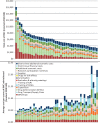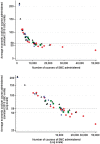Large-scale delivery of seasonal malaria chemoprevention to children under 10 in Senegal: an economic analysis
- PMID: 28981665
- PMCID: PMC5886061
- DOI: 10.1093/heapol/czx084
Large-scale delivery of seasonal malaria chemoprevention to children under 10 in Senegal: an economic analysis
Abstract
Seasonal Malaria Chemoprevention (SMC) is recommended for children under 5 in the Sahel and sub-Sahel. The burden in older children may justify extending the age range, as has been done effectively in Senegal. We examine costs of door-to-door SMC delivery to children up to 10 years by community health workers (CHWs). We analysed incremental financial and economic costs at district level and below from a health service perspective. We examined project accounts and prospectively collected data from 405 CHWs, 46 health posts, and 4 district headquarters by introducing questionnaires in advance and completing them after each monthly implementation round. Affordability was explored by comparing financial costs of SMC to relevant existing health expenditure levels. Costs were disaggregated by administration month and by health service level. We used linear regression models to identify factors associated with cost variation between health posts. The financial cost to administer SMC to 180 000 children over one malaria season, reaching ∼93% of children with all three intended courses of SMC was $234 549 (constant 2010 USD) or $0.50 per monthly course administered. Excluding research-participation incentives, the financial cost was $0.32 per resident (all ages) in the catchment area, which is 1.2% of Senegal's general government expenditure on health per capita. Economic costs were 18.7% higher than financial costs at $278 922 or $0.59 per course administered and varied widely between health posts, from $0.38 to $2.74 per course administered. Substantial economies of scale across health posts were found, with the smallest health posts incurring highest average costs per monthly course administered. SMC for children up to 10 is likely to be affordable, particularly where it averts substantial curative care costs. Estimates of likely costs and cost-effectiveness of SMC in other contexts must account for variation in average costs across delivery months and health posts.
Keywords: Seasonal malaria chemoprevention (SMC); Sub-Saharan Africa; campaigns; community health workers; cost function; cost variation; intermittent preventive treatment; malaria; mass drug administration; primary health care.
© The Author 2017. Published by Oxford University Press in association with The London School of Hygiene and Tropical Medicine.
Figures



References
-
- Ba EH, Pitt C, Dial Y. et al. 2017. Implementation, coverage and equity of large-scale door-to-door delivery of seasonal malaria chemoprevention to children under 10 years of age in Senegal. [Working Paper]. - PubMed
-
- Bureau of Labor Statistics. 2013. Consumer Price Index Inflation Calculator http://www.bls.gov/data/inflation_calculator.htm. 4 April 2011
MeSH terms
Substances
Grants and funding
LinkOut - more resources
Full Text Sources
Other Literature Sources
Medical

